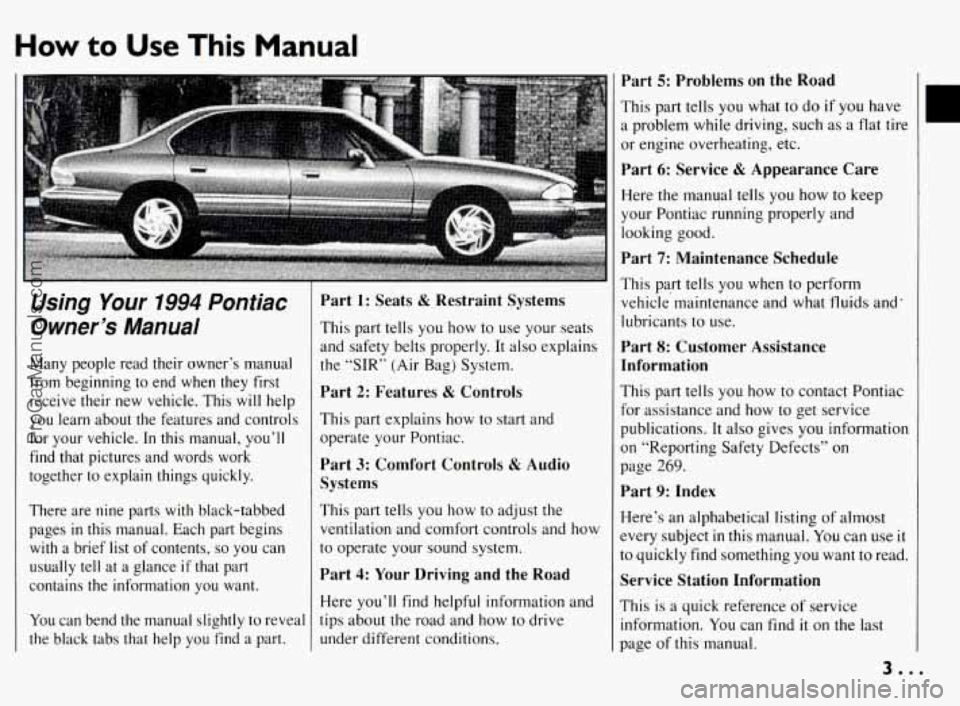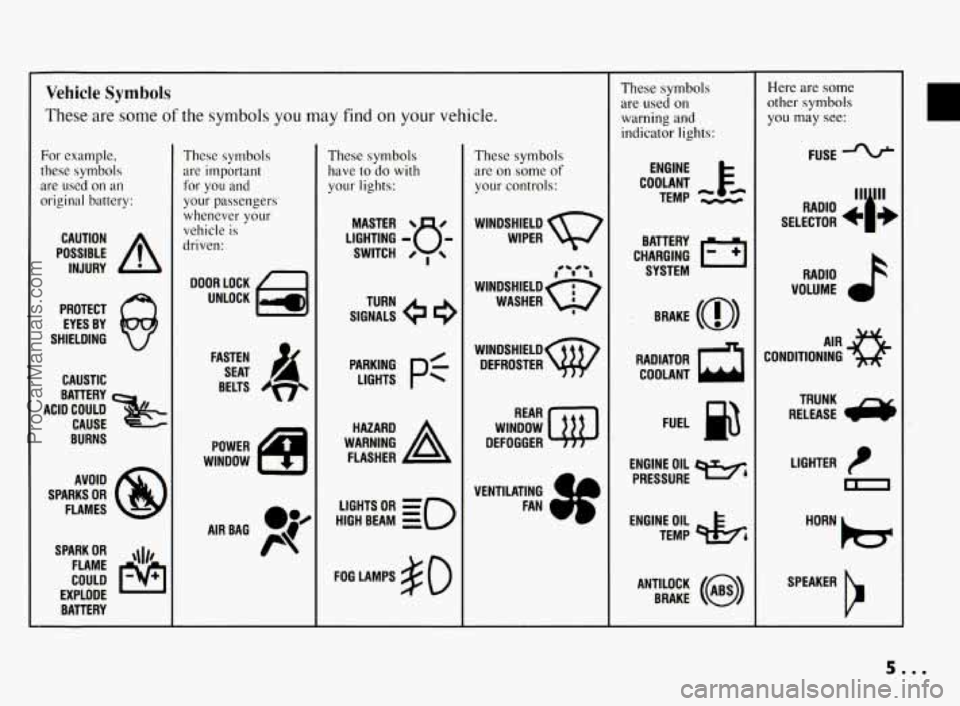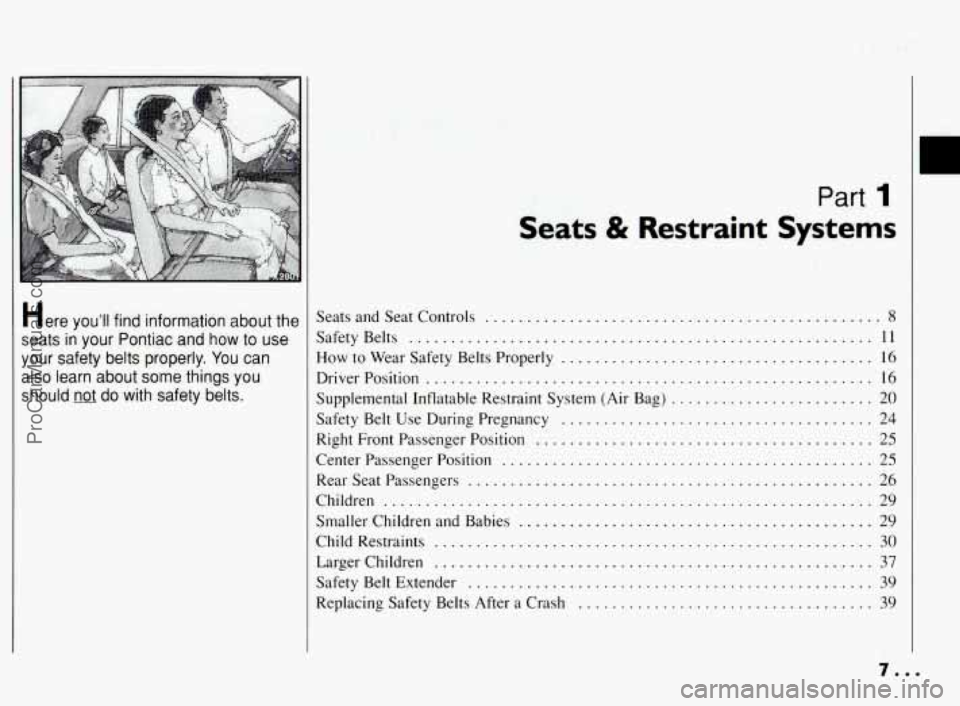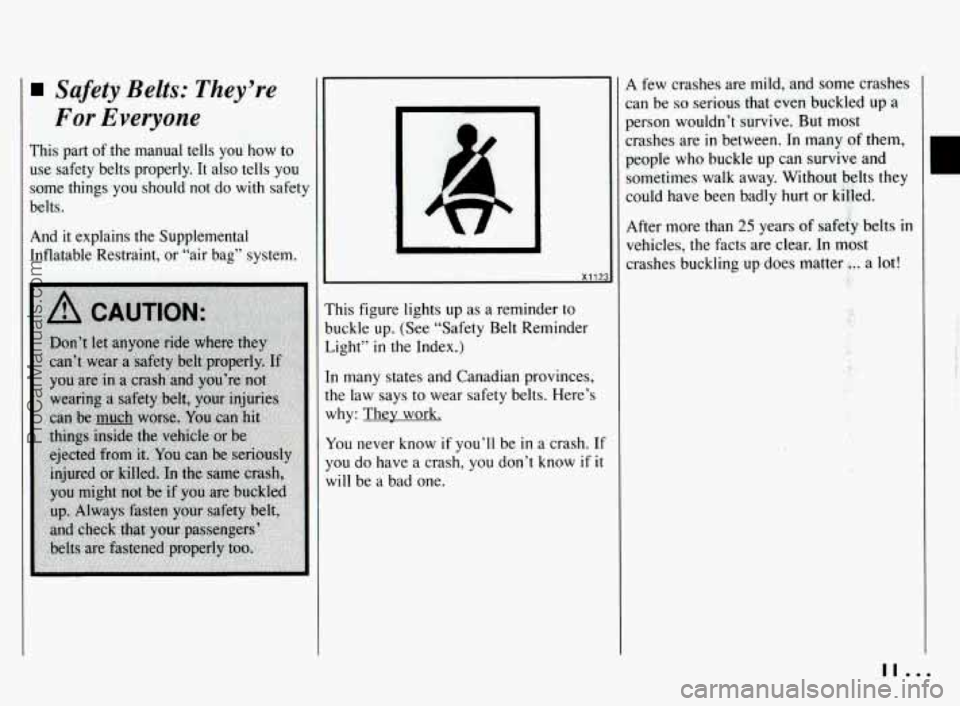Page 4 of 290

How to Use This Manual
Using Your 1994 Pontiac
Owner’s Manual
Many people read their owner’s manual
from beginning
to end when they first
receive their
new vehicle. This will help
you learn about the features and controls
for your vehicle. In this manual, you’ll
find that pictures and words work
together
to explain things quickly.
There are nine parts with black-tabbed pages
in this manual. Each part begins
with a brief list of contents,
so you can
usually tell at a glance
if that part
contains the information you want.
You can bend the manual slightly to reveal
the black tabs that help you find a part.
This part tells you how to use your seats
and safety belts properly. It also explains
the “SIR’ (Air Bag) System.
Part 2: Features & Controls
This part explains how to start and
operate your Pontiac.
Part 3: Comfort Controls & Audio
Systems
This part tells you how to adjust the
ventilation and comfort controls and how
to operate your sound system.
Part 4: Your Driving and the Road
Here you’ll find helpful information and
tips about the road and how
to drive
under different conditions.
Part 5: Problems on the Road
This part tells you what to do if you have
a problem while driving, such as a flat tire
or engine overheating, etc.
Part 6: Service & Appearance Care
Here the manual tells you how to keep
your Pontiac running properly and
looking good.
Part 7: Maintenance Schedule
This part tells you when to perform
vehicle’maintenance and what fluids and’
lubricants to use.
Part 8: Customer Assistance
Information
This part tells you how to contact Pontiac
for assistance and how
to get service
publications. It also gives
you information
on “Reporting Safety Defects”
on
page 269.
Part 9: Index
Here’s an alphabetical listing of almost
every subject
in this manual. You can use it
to quickly find something you want to read.
Service Station Information
This is a quick reference of service
information.
You can find it on the last
page of this manual.
3..
ProCarManuals.com
Page 6 of 290

Vehicle Symbols
These are some of the symbols you may find on your vehicle.
For example,
these symbols
are used on an
original battery:
POSSIBLE A
CAUTION
INJURY
PROTECT EYES BY
SHIELDING
CAUSTIC
ACID COULD BATTERY
CAUSE
BURNS
AVOID
SPARKS
OR
FLAMES
SPARK
OR ,111,
COULD FLAME
EXPLODE BATTERY
These symbols
are important
for you and
your passengers
whenever your
vehicle
is
driven:
DOOR LOCK
UNLOCK
FASTEN SEAT
4
BELTS
POWER
WINDOW
'* -- I
These symbols
have to do with
your lights:
SIGNALS e
TURN
HIGH BEAM
OR = =o
FOG LAMPS $0
These symbols
are
on some of
your controls:
WIPER Q7
WINDSHIELD
DEFROSTER
WINDOW
DEFOGGER
VENTILATING
4
FAN (I
These symbols
are used
on
warning and
indicator lights:
COOLANT Fa
TEMP --
ENGINE
CHARGING
I-1
BATTERY SYSTEM
BRAKE
(0)
RADIATOR COOLANT
FUEL
ENGINE OIL
PRESSURE
Wb
TEMP OIL ?b
ANTILOCK (@)
BRAKE
Here are some
other symbols
you may see:
FUSE
11lp RADIO , - -
SELECTOR b I JE
RADIO
VOLUME
CONDITIONING
AIR 43
LIGHTER
m
SPEAKER
b
5.00
ProCarManuals.com
Page 8 of 290

Here YOU’II find information about the
seats in your Pontiac and
how to use
your safety belts properly
. You can
also learn about some things you
should
not do with safety belts .
Part 1
Seats & Restraint Systems
Seats and Seat Controls ............................................... 8
Safety Belts ....................................................... 11
How to Wear Safety Belts Properly ..................................... 16
DriverPosition ..................................................... 16
Safety Belt Use During Pregnancy ..................................... 24
Right Front Passenger Position ........................................ 25
Center Passenger Position ............................................ 25
Rear Seat Passengers ................................................ 26
Children ........................................................ 29
Smaller Children and Babies
........................................ 29
Child Restraints
.................................................... 30
Safety Belt Extender
................................................ 39
Replacing Safety Belts After a Crash
................................... 39
Supplemental
Inflatable Restraint System (Air Bag)
........................ 20
Larger Children .................................................... 37
ProCarManuals.com
Page 12 of 290

Safety Belts: They’re
For Everyone
This part of the manual tells you how to
use safety belts properly. It also tells you
some things you should not do with safety
belts
.
And it explains the Supplemental
Inflatable Restraint, or “air bag” system.
This figure lights up as a reminder to
buckle
up. (See “Safety Belt Reminder
Light”
in the Index.)
In many states and Canadian provinces,
the law says to wear safety belts. Here’s
why: They work.
You never know if you’ll be in a crash. If
you do have a crash, you don’t know
if it
will be a bad one.
A few crashes are mild, and some crashes
:an be
so serious that even buckled up a
person wouldn’t survive.
But most
:rashes are
in between. In many of them,
people who buckle up can survive and
sometimes walk away. Without belts they
could have been badly hurt or killed.
After more than
25 years of safeiy belts in
vehicles, the facts are clear. In most
crashes buckling up does matter
4.. a lot!
.:5 ”
,? , ‘i I
,
r
II ...
ProCarManuals.com
Page 13 of 290
Seats & Restraint Systems
Why Safety Belts Work
When you ride in or on anything, you go
as fast as
it goes.
For example, if the bike is going 10 mph
(16 km/h), so is the child. When the bike hits
the block, it stops.
But
the child keeps going!
ProCarManuals.com
Page 15 of 290
Seats & Restraint Systems
Why Safety Belts Work
(COrV7y
The person keeps going until stopped by
something.
In a real vehicle,
it could be the
windshield
...
0 0.14
or the instrument panel ... or the safety belts!
With safety belts,
you slow down as the
vehicle does.
You get more time to stop.
You stop over more distance, and your
strongest bones take the forces. That’s
why safety belts make such good sense.
ProCarManuals.com
Page 16 of 290

Here Are Questions
Many People Ask
About Safety Belts --
and the Answers
Q: Won’t I be trapped in the vehicle
after an accident if
I’m wearing a
safety belt?
A: You could be -- whether you’re
wearing a safety belt
or not. But you
can easily unbuckle a safety belt, even
if you’re upside down. And your
chance of being conscious during and
after an accident,
so you can unbuckle
and get
out, is much greater if you are
belted.
Q: Why don’t they just put in air bags
so people won’t have to wear safety
belts?
A: Air bags, or Supplemental Inflatable
Restraint systems, are
in some
vehicles today and
will be in more of
them in the future. But they are
supplemental systems only
-- so they
work safety belts, not instead
of
them. Every air bag system ever
offered for sale has required the use of safety belts.
Even
if you’re in a
vehicle that has air bags, you still have
to buckle up to get the most
protection. That’s true not only
in
frontal collisions, but especially in
side and other collisions.
Q: If I’m a good driver, and I never
drive far from home, why should
I
wear safety belts?
A: You may be an excellent driver, but if
you’re in an accident -- even one that
isn’t your fault
-- you and your
passengers can be hurt. Being a good
driver doesn’t protect you from things
beyond your control, such as bad
drivers.
Most accidents occur within 25 miles
(40 km) of home. And the greatest
number of serious injuries and deaths
occur at speeds
of less than 40 mph
(65 km/h).
Safety belts are for everyone.
BELTS
Safety Belt Reminder
Light
Yhen the key is turned to “Run” or
Start”, a chime will come on for about
ight seconds to remind people
to fasten
heir safety belts. The safety belt light
vi11 also come on and stay on for about
10 seconds. If the driver’s belt is already
buckled, neither the chime nor the light
vill come on.
C
15...
ProCarManuals.com
Page 17 of 290
Seats & Restraint Systems
How To Wear Safety
Belts
Properly
Adults
This section is only for people of adult
size.
Be aware that there are special things to
know about safety belts and children.
And there are different rules for smaller
children and babies.
If a child will be
riding in your Pontiac, see the section
located later
in this part called “Children.’’
Follow those rules for everyone’s
protection.
First, you’ll want to know which restraint
systems your vehicle has.
We’ll start with the driver position.
Driver Position
This section describes the driver’s
restraint system.
lap-Shoulder Belt
The driver has a lap-shoulder belt. Here’s
low to wear it properly.
I. Close and lock the door.
2. Adjust the seat (to see how, see
“Seats” in the Index)
so you can sit up
straight.
. . . 16
ProCarManuals.com